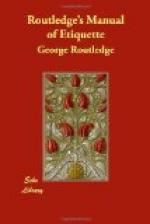Fashion gives, as it were, the key-note—supplies the hint, which is taken and followed as people can. It is absurd to suppose that its laws are stringent, and not elastic, or that all persons must conform exactly to its “dicta.” Who shall say that all must dress alike? Tall and short, fat and lean, stout and scraggy, cannot be made equally subject to the same rule. In such a matter as dress there must be some margin allowed for individual peculiarities. Nature has not made us all in the same mould; and we must be careful not to affront nature, but must accept her gifts and make the best of them.
There is one point connected with the following of fashion which requires some attention, and which, if attended to, will preserve us from incongruities. We allude to the disposition of some persons to use various fashions together. They are inclined to be “eclectic.” They select from by-gone fashions, and endeavour to blend them with those which prevail. The result is a painful incongruity. Who would dream of placing a Grecian portico to an Elizabethan building? Why then endeavour to combine old fashions with new? Why attempt to wear a bonnet of almost primitive form with dresses of modern dimensions and style? or why wear flounces when they are out of fashion, and full skirts when everything is "gored" into plainness? It is necessary to pay some attention to the present style of dress, if ladies desire to avoid peculiarities and wish to please. But it, of course, requires a certain sense of propriety and of fitness. A bonnet of diminutive form which suits to perfection a young girl with a small oval face and slender throat, is quite misapplied when adopted by a woman of a certain age, whose figure has escaped beyond the limits of even “embonpoint,” whose throat is not perceptible, and whose face and head are large. She requires something of more ample dimensions, that bears some affinity in size with the head and face it is intended to ornament; something which will modify, if not conceal, the imperfections which time has developed. A dress of a light and airy kind does not become a matron; nor can that which suits a slight and elastic figure be worn with impunity by what is called a “comely dame.”




